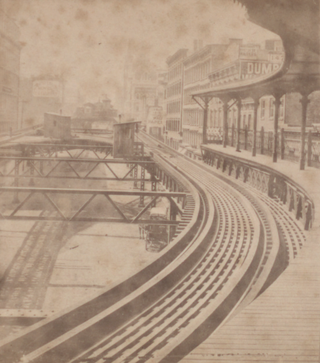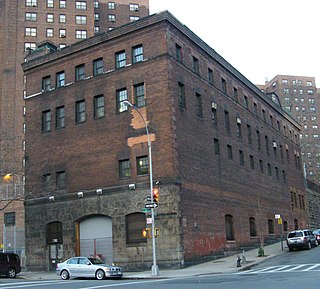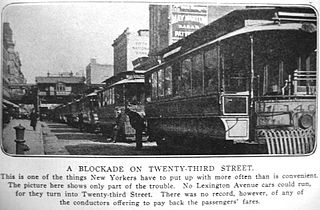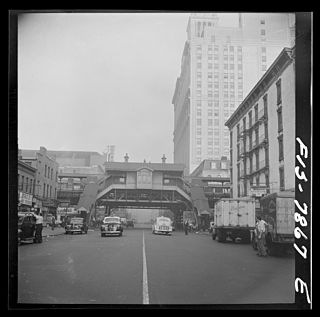
The IRT Ninth Avenue Line, often called the Ninth Avenue Elevated or Ninth Avenue El, was the first elevated railway in New York City. It opened in July 1868 as the West Side and Yonkers Patent Railway, as an experimental single-track cable-powered elevated railway from Battery Place, at the south end of Manhattan Island, northward up Greenwich Street to Cortlandt Street. By 1879 the line was extended to the Harlem River at 155th Street. It was electrified and taken over by the Interborough Rapid Transit Company in 1903.
The IRT Lexington Avenue Line is one of the lines of the A Division of the New York City Subway, stretching from Lower Manhattan north to 125th Street in East Harlem. The line is served by the 4, 5, 6, and <6> trains.
The 129th Street station was a transfer station on the IRT Third Avenue Line in Manhattan, New York City, shared by elevated trains of both the Third Avenue Line and IRT Second Avenue Line. The next stop to the north was 133rd Street for the main line and Willis Avenue for the Willis Avenue spur, both of which were across a swing bridge above the Harlem River in the Bronx. The next stop to the south was 125th Street−Third Avenue for Third Avenue Line trains and 125th Street−Second Avenue for Second Avenue Line trains.
The 125th Street station was an express station on the demolished IRT Third Avenue Line in Manhattan, New York City as part of the extension of the Third Avenue Line north of 67th Street. It opened on December 30, 1878, and had three tracks and two levels. The lower level was built first and had two tracks and two side platforms for local trains. The upper level, built as part of the Dual Contracts, had one track and two side platforms for express trains. Simultaneously during the dual contracts period, IRT also expanded the Lexington Avenue Subway which included a station one block west of the el station. This station closed on May 12, 1955, with the ending of all service on the Third Avenue El south of 149th Street.
The 116th Street station was a local station on the demolished IRT Third Avenue Line in Manhattan, New York City. The outer tracks had two side platforms for local trains, and was built first. The center track was built as part of the Dual Contracts for express trains. This station closed on May 12, 1955, with the ending of all service on the Third Avenue El south of 149th Street.
The 106th Street station was an express station on the demolished IRT Third Avenue Line in Manhattan, New York City. The station was opened on December 30, 1878, and had two levels. The lower level had two tracks and two side platforms and served local trains. The upper level had one track and two side platforms over the local tracks on the lower level and served express trains. It was built as part of the Dual Contracts. The express run from this stop to 42nd Street was the longest express segment out of all New York City elevated lines, bypassing eight local stations. This station closed on May 12, 1955, with the ending of all service on the Third Avenue El south of 149th Street.

The 42nd Street station was an elevated express station on the demolished IRT Third Avenue Line in Manhattan, New York City. It had two levels with the lower level having three tracks. The main line tracks were served by two side platforms. A side platform connected to the southbound platform was used for shuttle service to Grand Central. The upper level was built as part of the Dual Contracts, and had one track and two side platforms over the two local tracks.

The 99th Street station was a local station on the demolished IRT Third Avenue Line in Manhattan, New York City. The station was originally built by the Manhattan Railway Company on December 30, 1878, and later had two levels. The lower level serving local trains was built first, and had two tracks and two side platforms. The upper level, built as part of the Dual Contracts had one track that bypassed the station and served express trains. This station closed on May 12, 1955, with the ending of all service on the Third Avenue El south of 149th Street. South of the station were connecting tracks to the 98th Street Yard. The station was also located next to Substation 7 an old IRT substation designed not only in order to electrify the Third Avenue Line, but the Second and Ninth Avenue elevated lines as well. Later it even served as a power source for the IRT Lexington Avenue Line from 1918 until the 1970s. The substation is still owned by the MTA and has been listed on the National Register of Historic Places since February 9, 2006.
The 89th Street station was a local station on the demolished IRT Third Avenue Line in Manhattan, New York City. It was originally built on December 9, 1878. The outer tracks were served by local trains and two side platforms. The center track was built as part of the Dual Contracts, it bypassed the station and served express trains. 89th Street station was the terminus of the IRT Third Avenue Line until it was expanded to 129th Street on December 30, 1878. This station closed on May 12, 1955, with the ending of all service on the Third Avenue El south of 149th Street. North of the station were connecting tracks to the 98th Street Yard.

The 23rd Street station was an express station on the demolished IRT Third Avenue Line in Manhattan, New York City. It had two levels. The lower level was served by local trains and had two tracks and two side platforms. It was built first. The upper level was built as part of the Dual Contracts and had one track with two side platforms and served express trains. This station closed on May 12, 1955, with the ending of all service on the Third Avenue El south of 149th Street.

The 14th Street station was a local station on the demolished IRT Third Avenue Line in Manhattan, New York City. It had two levels. The lower level was served by local trains and had two tracks and two side platforms. It was built first. The upper level was built as part of the Dual Contracts and had one track that bypassed the station and served express trains. In 1924, the Brooklyn–Manhattan Transit Corporation built the 14th Street-Eastern District Line Subway below the station, which included the Third Avenue subway station. Although this station was located above the Third Avenue BMT subway station on what is today known as the BMT Canarsie Line, the two stations were never connected. This station closed on May 12, 1955, with the ending of all service on the Third Avenue El south of 149th Street.

The Chatham Square station was an express station on the demolished IRT Third Avenue Line in Manhattan, New York City. It had two levels. The lower level had two tracks and one island platform that served trains of both the IRT Second Avenue Line and IRT Third Avenue Line. The upper level had three tracks and two island platforms that served trains of both lines going to and from City Hall. Second Avenue trains served the station until June 13, 1942, and City Hall Spur trains served the station until December 31, 1953. This station closed entirely on May 12, 1955, with the ending of all service on the Third Avenue El south of 149th Street.
The 86th Street station was an express station on the demolished IRT Second Avenue Line in Manhattan, New York City. It had two levels. The lower level had two tracks and two side platforms, and was served by local trains. The upper level was built as a part of the Dual Contracts and had one track and two side platforms for express trains. The next stop to the north was 92nd Street for local trains and 125th Street for express trains. The next stop to the south was 80th Street for local trains and 57th Street for express trains. The station closed on June 11, 1940. The site is now served by the 86th Street station of the Second Avenue Subway.
The 30th Street station was a local station on the demolished IRT Ninth Avenue Line in Manhattan, New York City. It was opened on December 13, 1873 as the replacement for the original northern terminus of the Ninth Avenue Line at 29th Street, which was built in 1868 The station which was originally built by the New York Elevated Railroad Company had two levels. The lower level was built first and had two tracks and two side platforms. The upper level was built as part of the Dual Contracts and had one track that served express trains that bypassed the station. It closed on June 11, 1940. The next southbound stop was 23rd Street. The next northbound stop was 34th Street.
The 66th Street station was an express station on the demolished IRT Ninth Avenue Line in Manhattan, New York City. It had two levels. The lower level was built first and had two tracks and two side platforms. The upper level was built as part of the Dual Contracts and had one track and two side platforms over the lower level local tracks. The station closed on June 11, 1940. The next southbound local stop was 59th Street. The next southbound express stop was 34th Street for Ninth Avenue trains, and 50th Street for IRT Sixth Avenue Line express trains. The next northbound local stop was 72nd Street. The next northbound express stop was 116th Street. The express run from this stop to 116th Street was the longest express segment out of all New York City elevated lines, bypassing seven local stations.
The 59th Street station was a local station on the demolished IRT Ninth Avenue Line in Manhattan, New York City. It had two levels. The lower level was built first and had two tracks and two side platforms that served local trains. The upper level was built as part of the Dual Contracts and had one track that served express trains. It closed on June 11, 1940. The next southbound stop was 50th Street for Ninth Avenue trains and Eighth Avenue for IRT Sixth Avenue Line trains. The next northbound stop was 66th Street.

The Sedgwick Avenue station was an elevated, ground level and underground station on the Bronx extension of the IRT Ninth Avenue Line in Highbridge, Bronx, New York City.

The Anderson–Jerome Avenues station was an elevated and partially underground station on the Bronx extension of the IRT Ninth Avenue Line in Highbridge, Bronx, New York City.








